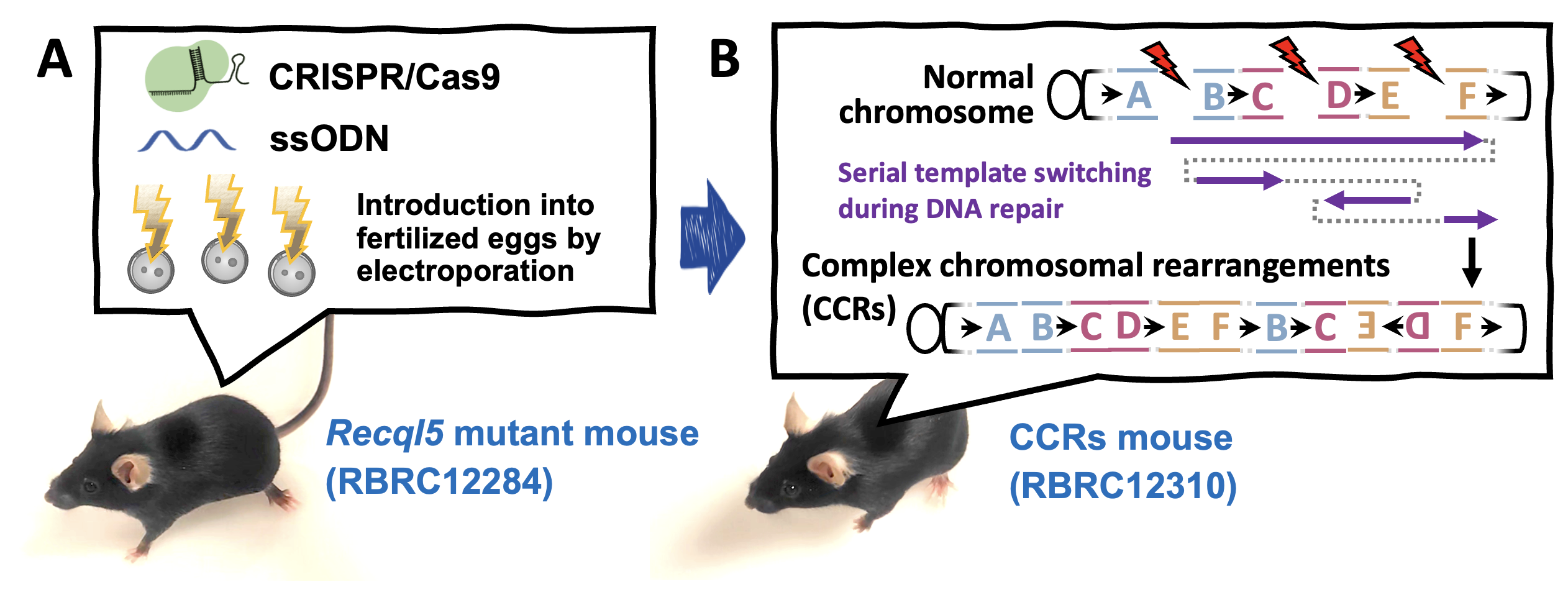 |
April 2025 Mouse of the Month |
|
Induction of chromoanasynthesis C57BL/6N-Recql5<em1Chuan> (RBRC12284)
|
|
| The Recql5 gene is a member of the DNA helicase RecQ family involved in DNA replication, transcription, and repair. Null mutant mice for most DNA repair genes are embryonic lethal. However, Recql5 gene null mutant mice survive to adulthood. Depositors (Dr. Satoru Iwata and Dr. Takashi Iwamoto) and their colleagues focused on these findings. Using fertilized eggs from Recql5 gene frameshift mutant mice (RBRC12284) and CRISPR/Cas9 technology, they attempted to induce complex chromosomal rearrangements (CCRs). The resulting genome-edited mice were subjected to next-generation sequencing analysis, which revealed a novel genomic phenomenon called chromoanasynthesis, in which complex chromosomal rearrangements are formed simultaneously. They were able to combine three or more chromosome fragments, which had previously been difficult to do. In fact, a mouse strain carrying a duplication and an inversion, along with three fusion genes on chromosome 10 (RBRC12310), which was generated by inducing three DNA double strand breaks (DSBs) in the Recql5 gene mutant mouse zygotes, has been deposited. Chromosomal rearrangements occur frequently in vivo, and CCRs have been reported to be associated with cancer and congenital diseases. The generation of genome-edited mice using Recql5 mutant mice will be useful for the generation of novel mouse models different from conventional ones and will be contribute to the elucidation of life mechanisms and applications in disease research. |
| Keywords | : | DNA repair, chromosomal rearrangement, CRISPR/Cas9, chromoanasynthesis, next-generation sequencing analysis | |
| Depositors | : | Satoru Iwata, Ph.D. and Takashi Iwamoto, M.D., Ph.D. (Chubu University) | |
| Strain name | : | C57BL/6N-Recql5<em1Chuan> | |
| RBRC No. | : | RBRC12284 | |
| Strain name | : | C57BL/6N-Dp(Hmga2-Rassf3)<em4Chuan>In(10)<em4Chuan> | |
| RBRC No. | : | RBRC12310 | |
| Reference | : | [1] | Iwata S, Nagahara M, Ido R, Iwamoto T. A Recql5 mutant facilitates complex CRISPR/Cas9-mediated chromosomal engineering in mouse zygotes. Genetics. 2024 Jun 5;227(2):iyae054. |
| April 2025 Saori Mizuno, Ph.D. Contact: Experimental Animal Division, RIKEN BioResource Research Center (animal.brc@riken.jp) All materials contained on this site may not be reproduced, distributed, displayed, published or broadcast without the prior permission of the owner of that content. |





